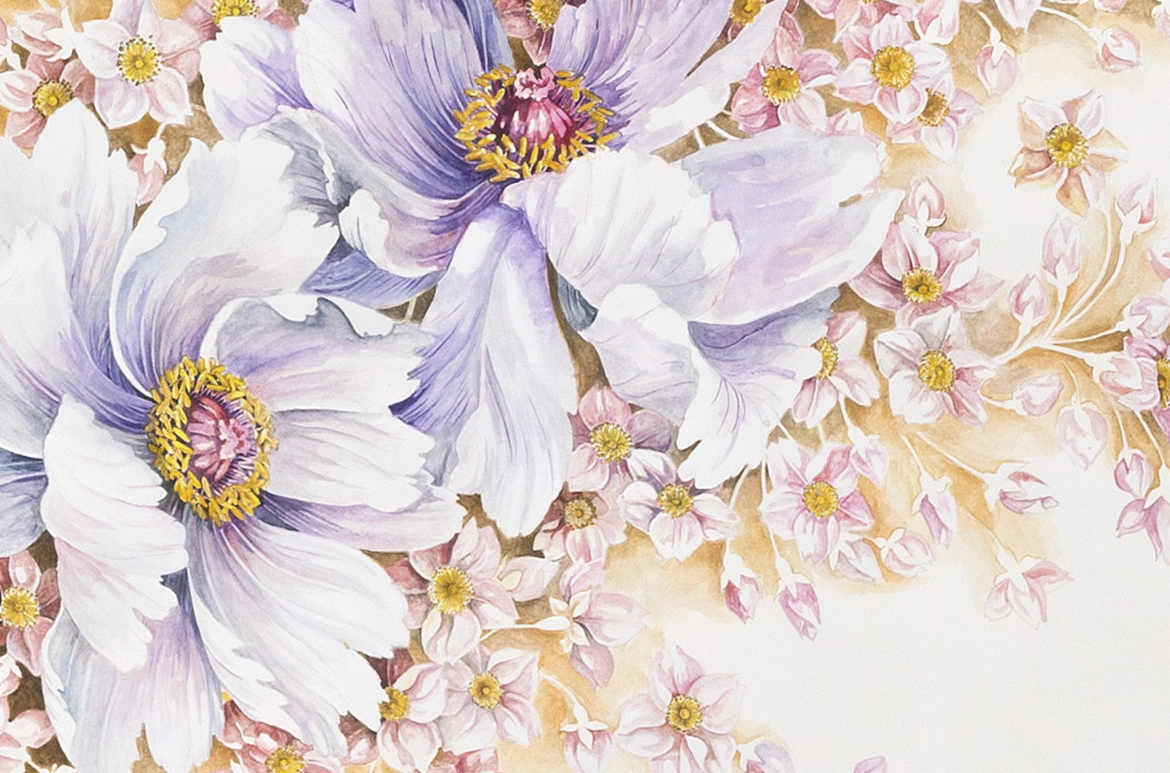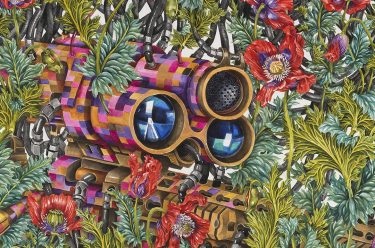Despite eX de Medici’s proclivity for privacy, she is no shrinking violet. In lieu of a conspicuous public profile, she is content to let her artworks proclaim her outrage at the endemic violence and political hypocrisy she sees unfolding around her. As an artist and tattooist who began studying in the early 1980s, and whose early practice encompassed photocopy and performance, she has consistently stormed the barricades of art and used it to challenge the status quo. What, then, should we make of the work she has made since 1998, when she began to step back from professional tattooing — a skill she acquired through an Australia Council-funded apprenticeship in Los Angeles — and particularly of the watercolours that have been the mainstay of her practice for over 20 years?
The iconography in artworks such the beguiling and unsettling Eutelsat Has Turned You Off 2013 (detail illustrated, published in the exhibition catalogue and on view in ‘Beautiful Wickedness’) points us in numerous directions. If we begin with the symbolism of the flowers and their counterpart, the machine gun, we might legitimately consider a feminist interpretation in which the gendered associations of these motifs could be considered part of de Medici’s critique of patriarchal power structures. Equally, the artist’s methods, approaches and declarations reveal her socialist stance. As she has stated publicly,
I have, in my work, tried to examine the pernicious forces at work within the human hegemony — the fetishistic allure of power over the macro and the micro, the human and the non-human. The agents of that impulse: geo-economies, the law, the military and science, to achieve [. . .] control of the larger discourse. The centralisation of the means of production fascinates me like no other.1
eX de Medici ‘Eutelsat Has Turned You Off’ (detail) 2013
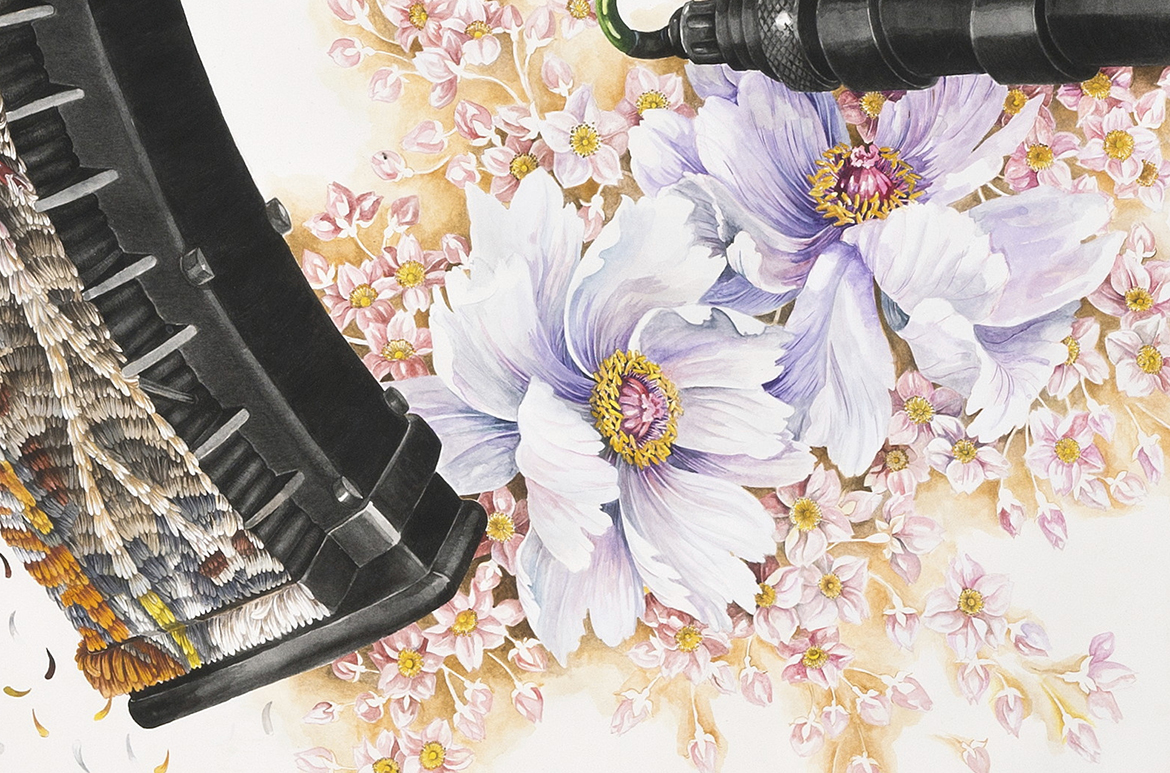
The former reading speaks of a clash between the ‘feminine’ forms of the peonies and cherry blossom (illustrated) and the ‘masculine’ imagery of the gun. These binaries extend throughout both the watercolour and de Medici’s practice: soft/hard, pretty/powerful, fragile/strong and so on. Implicit here is a criticism of male dominance, and at the same time, the cultural systems through which gendered constructs are perpetuated. In adopting the language of flower painting, de Medici is a knowing participant in these debates.
The biased associations between women and flower painting have been well‑documented by feminist art historians since the 1970s. Rozsika Parker and Griselda Pollock made the case convincingly arguing that, despite flower painting’s origins in Europe in the sixteenth century as a respected branch of still-life painting that reached its peak in Holland in the seventeenth century, the genre acquired a distinctly gendered and marginalised standing from the eighteenth century onwards.
As they contend:
Paintings of flowers and the women who painted them became mere reflections of each other. Fused into the prevailing notions of femininity, the painting[s] become… solely an extension of womanliness and the artist becomes a woman . . . fulfilling her nature.2
Parker and Pollock challenged this canon, documenting the achievements of artists such as Maria van Oosterwijck (1630–93), an esteemed Dutch painter whose Vanitas 1668 epitomises that tradition.
Van Oosterwijck’s ‘vanity’ painting expresses the idea that worldly possessions are fleeting fancies best avoided. The skull, the hourglass, the flowers in full bloom and the butterflies that hover around them embody life’s transience, our own mortality, and a moral directive to shun earthly delights.
The co-authors also foregrounded the practice of the German entomologist and illustrator who de Medici cites as an influence, Maria Sybilla Merian (1647–1717), the first person to record the metamorphosis of the butterfly. Notably, they acknowledge Merian’s three-volume catalogue The Wonderful Transformation of Caterpillars and [their] Singular Plant Nourishment, published between 1679 and 1717, and quote Linda Nochlin and Sutherland Harris’s argument that Merian ‘revolutionized the sciences of zoology and botany and laid the foundation for the classification of plant and animal species made by Charles [sic] Linnaeus [1707–78] in the eighteenth century’.3
De Medici acknowledges this history in Eutelsat Has Turned You Off while adding decidedly contemporary twists, scale being the most obvious. The work’s physicality and symbolism are confronting, and intrinsic to her project to condemn the weapon. Here, the ‘worldly possession’ is the AK-47, an emblem of death that epitomises global grabs for power and the technologies that enable them. The fragile flowers remain with a sting in the tail — cherry blossom contains coumarin, which is toxic if ingested in large quantities — and the butterflies have morphed into moths.
eX de Medici ‘Eutelsat Has Turned You Off’ (detail) 2013
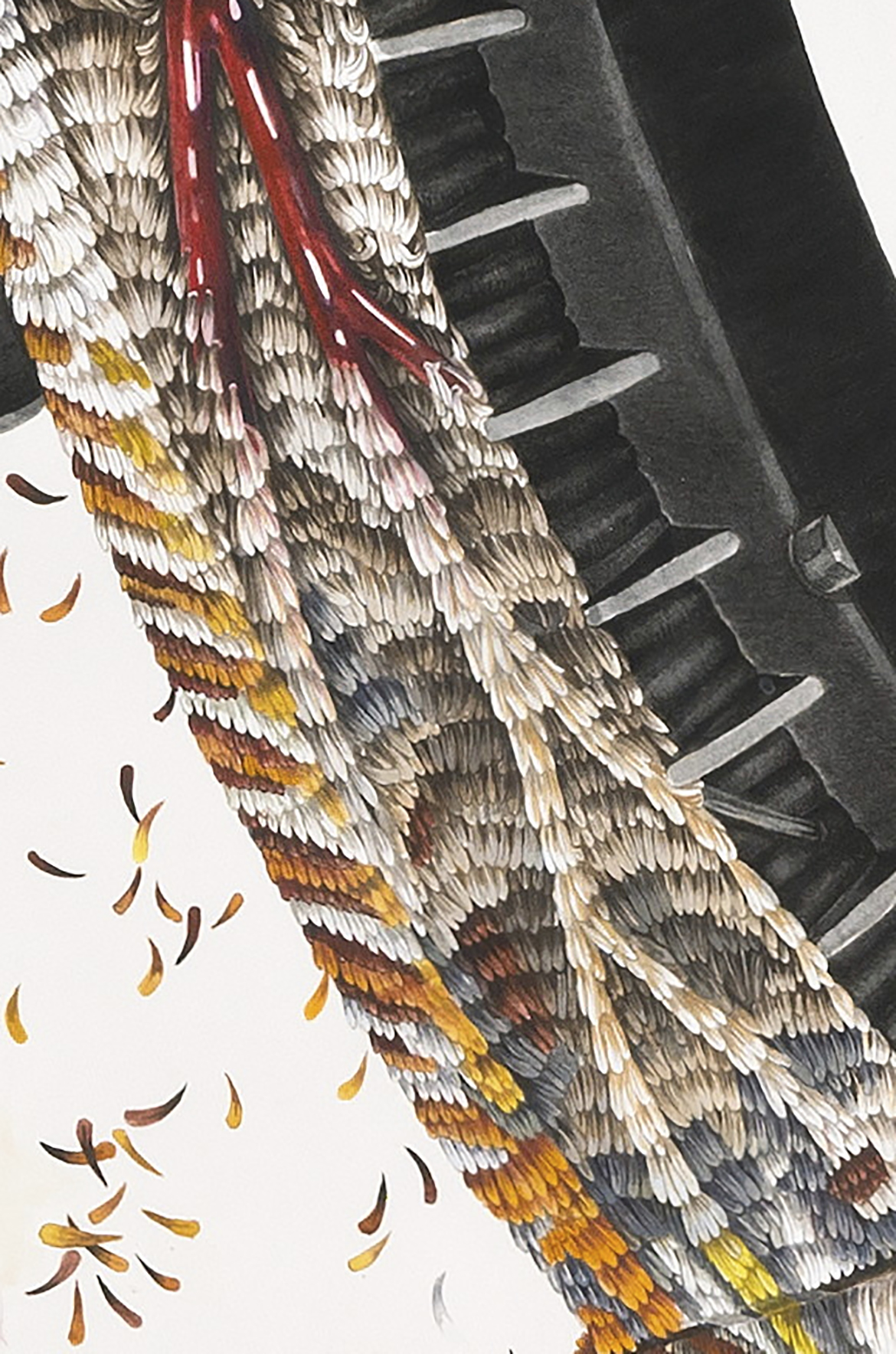
eX de Medici ‘CSIRO/ANIC Study’ #5 2001
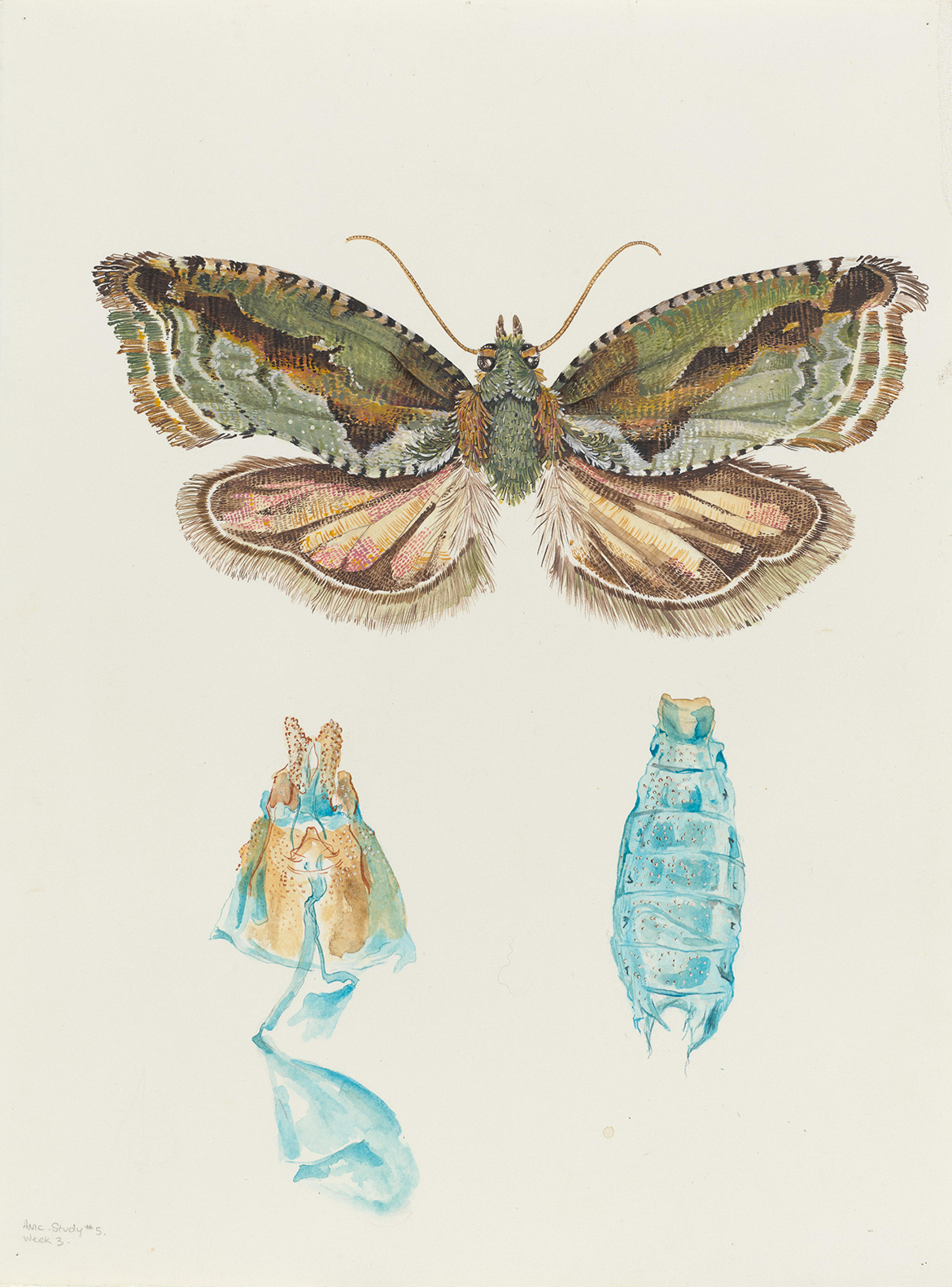
paper / 38.5 x 28.5cm (irreg.) / Private collection, Canberra / © eX de Medici / Photograph: Merinda Campbell
The scales that cover the rifle’s magazine are, as de Medici has described, from ‘an unnamed micro moth from the Tortricidae family’ (illustrated), which she painted during one of the many residencies she has undertaken at the CSIRO’s Australian National Insect Collection (ANIC).4 Her meeting at ANIC in 2000 with taxonomist and evolutionist Dr Marianne Horak proved formative and engendered an ongoing partnership. As the artist has explained: ‘I have . . . a strong interest in science that has been developed through my work with the CSIRO. I listen to a lot and read a lot about science’.5
Ferdinand Bauer ‘Stewartia Serrata’ c. early 1800s
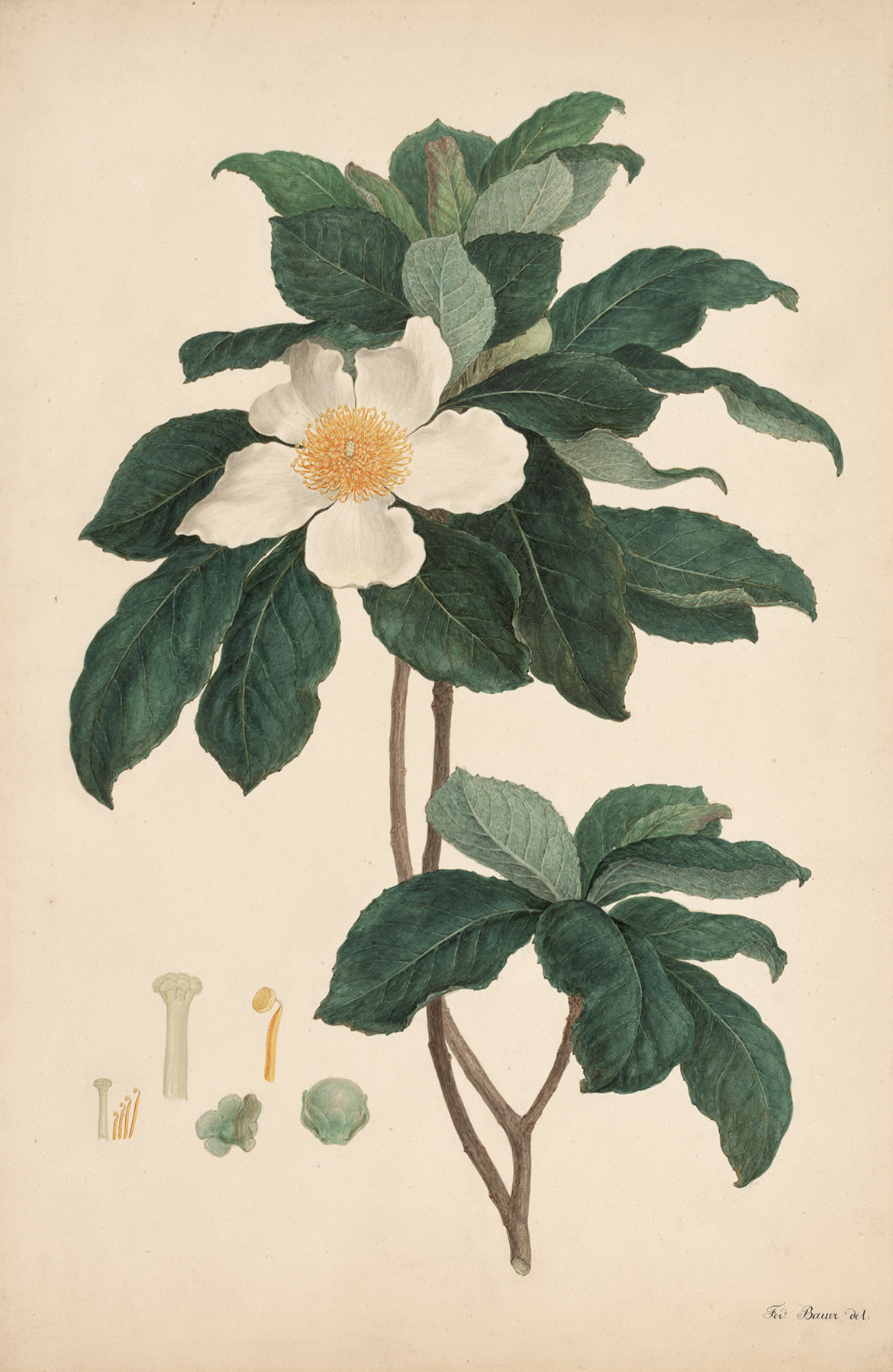
eX de Medici ‘Untitled (Banksia Serrata)’ 1998
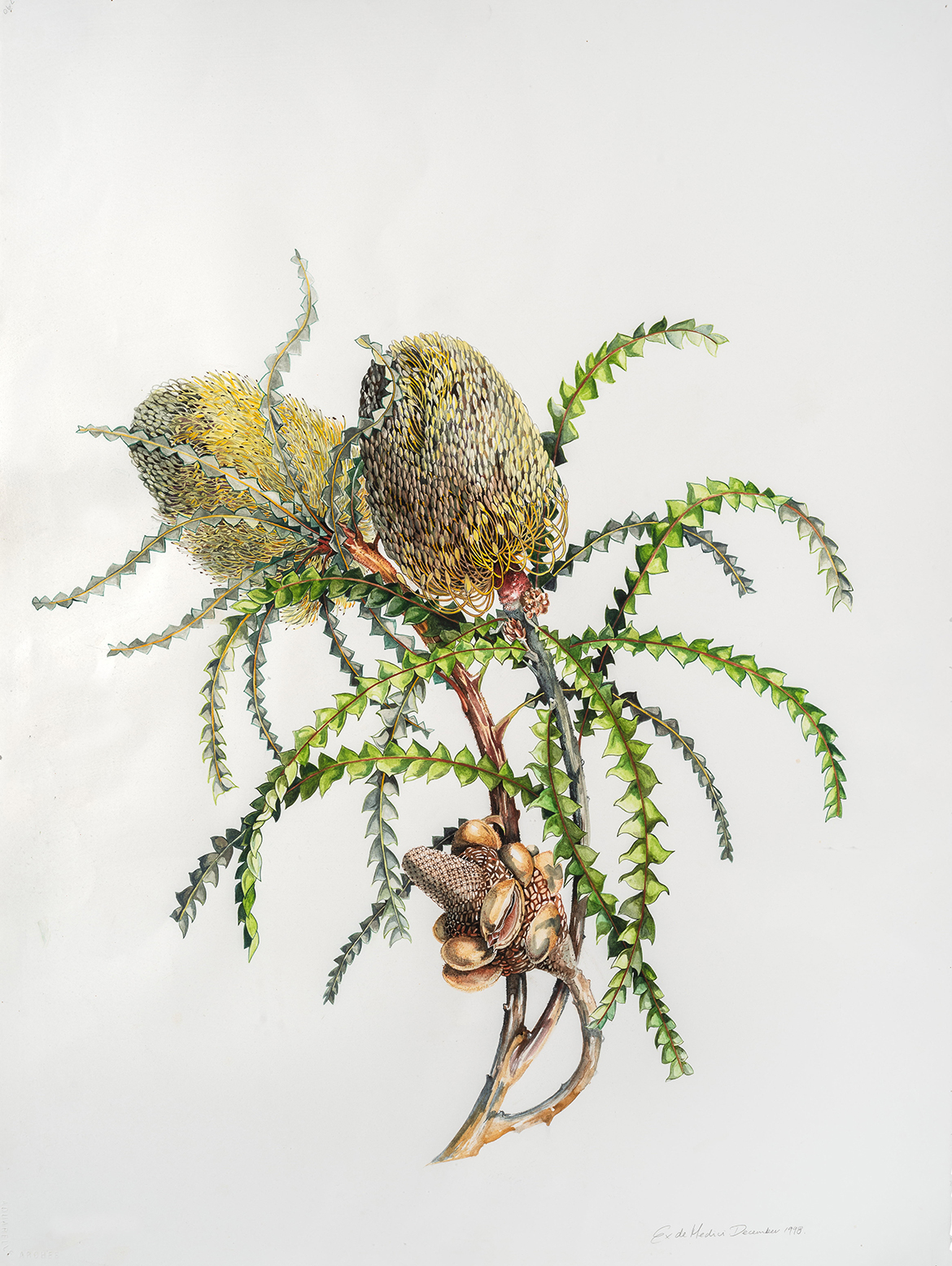
De Medici’s fascination with natural-history illustration also stems from her infatuation with the watercolours of Ferdinand Bauer (1760–1826), the botanical artist who accompanied Mathew Flinders (1774–1814) on his 1801–03 voyage to circumnavigate Australia (illustrated Stewartia Serrata). Bauer’s work came to de Medici’s attention in 1998 in the exhibition ‘An Exquisite Eye: The Australian Flora and Fauna Drawings 1801–1820 of Ferdinand Bauer’. Apart from being in awe of Bauer’s technical and creative brilliance, his profession itself was an enticement. In her typically subversive style, de Medici has explained that ‘In art, [botanical illustration] is not considered art, which is always an attractive reason to get curious’.6
It is, moreover, the associations that the botanical tradition shares with colonisation that make it an ideal vehicle for de Medici: the naturalists and illustrators who joined voyages of exploration and conquest of the ‘New World’ were, through the taxonomic process, conscripted into recording, naming and claiming these lands. Intrinsic to this colonial project was the water-based medium in which the artists worked — easily transportable and esteemed, having acquired new status during the High Enlightenment (1730–80). In Eutelsat Has Turned You Off and in de Medici’s watercolours more broadly, she harnesses botany’s visual history in an extended metaphor around global expansionism.
And so, to the weapon that dominates the artwork, the North American adaptation of the AK-47 or Avtomat Kalashnikova — Kalashnikov’s Automatic Gun.7 It is the rifle’s complicated history and its entangled relationship with world politics that makes it perfectly suited to de Medici’s purpose. Designed by Mikhail Kalashnikov and manufactured by the Soviet Union from 1948, variants of the basic and ‘bulletproof’ firearm are now made around the world. The artist has summarised the impact of
the weapon concisely:
The first true mass deployment [of the AK-47] into the theatre of war was via the Soviet invasion of Afghanistan, where . . . no-one takes Afghanistan, yet Afghanistan takes the AK . . . The extraordinary simplicity of the weapon made it extremely easy and cheap to copy . . . Americans pride themselves as the greatest ever weapon designers and manufacturers, [yet] they secretly embrace the ‘enemy’s’ intellectual property, both Russian and . . . Middle East[ern].8
eX de Medici ‘Eutelsat Has Turned You Off’ (detail) 2013
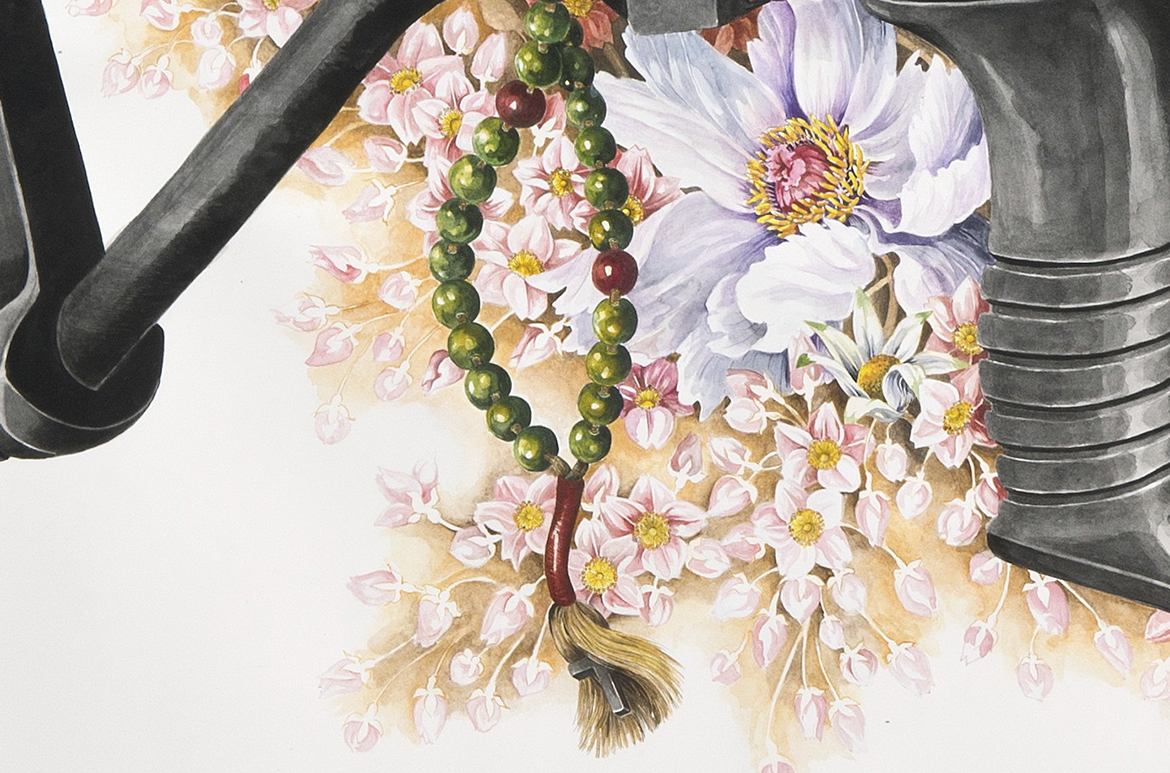
The imagery of the flowers thus represents de Medici’s censure of global politics, with the blooms standing in for nation states: the cherry blossom (Japan) and peonies (China) are enemies of the (United) States, with the flannel flower (Australia) secreted among the arrangement, the US’s somewhat emasculated confederate (illustrated).
The most significant layer of meaning in this complex web relates to the supremacy of the so-called ‘West’ and the corporate communication platforms enabling this, referred to in the title of the artwork. Eutelsat is one of the world’s three leading satellite operators, providing coverage to Europe, Africa, Asia, and the Americas. In this case, de Medici’s reference is to Iran, to which Eutelsat has supplied services despite the government’s broadly reported infringement of ‘basic telecommunications and human-rights standards’.9 In a world in which revenue trumps responsibility, where, the artist asks, does political posturing end and complicity begin? Who is ‘the enemy’ and who ‘the ally’? Will technology be our saviour or our downfall? And what of democracy? Within this polarised climate, Eutelsat Has Turned You Off is, like de Medici’s recent triptych System (This is the Place Where the Martyrs Grow) 2022 (detail illustrated, published in the exhibition catalogue and on view in ‘Beautiful Wickedness’), a stinging indictment of political duplicity, the military-industrial complex, and the machinery of war.
eX de Medici ‘System (This is the Place Where the Martyrs Grow)’ 2022
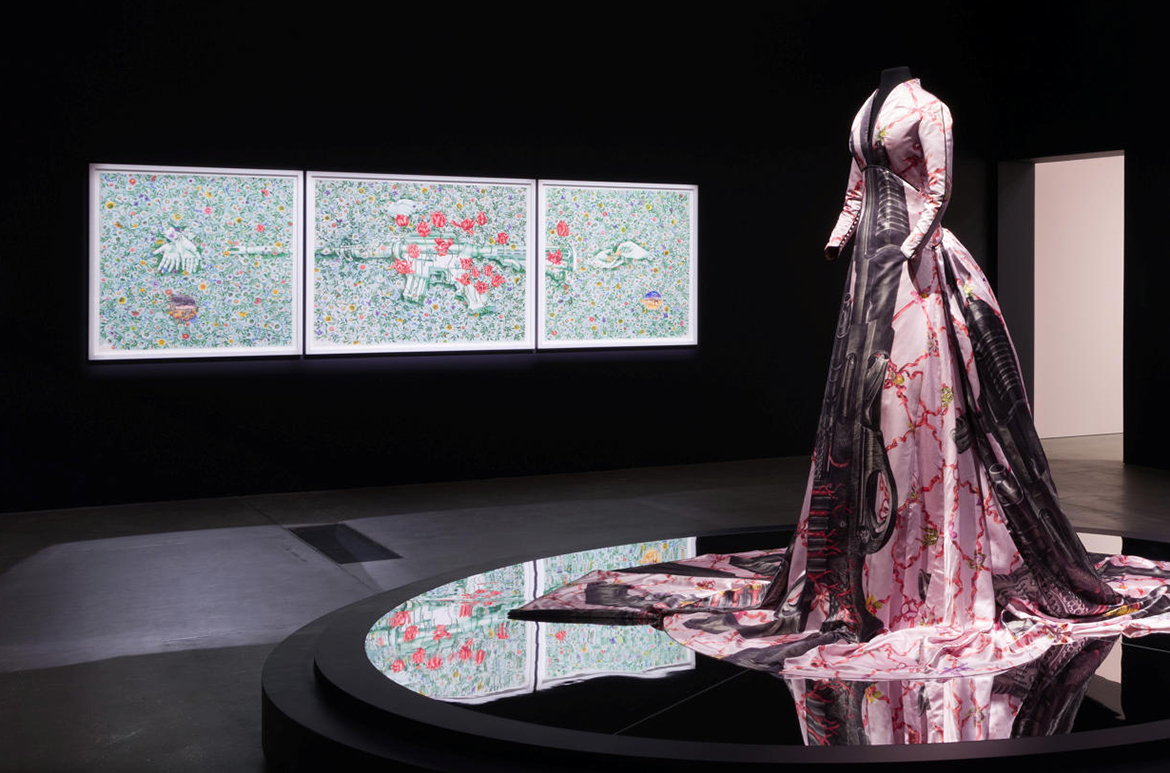
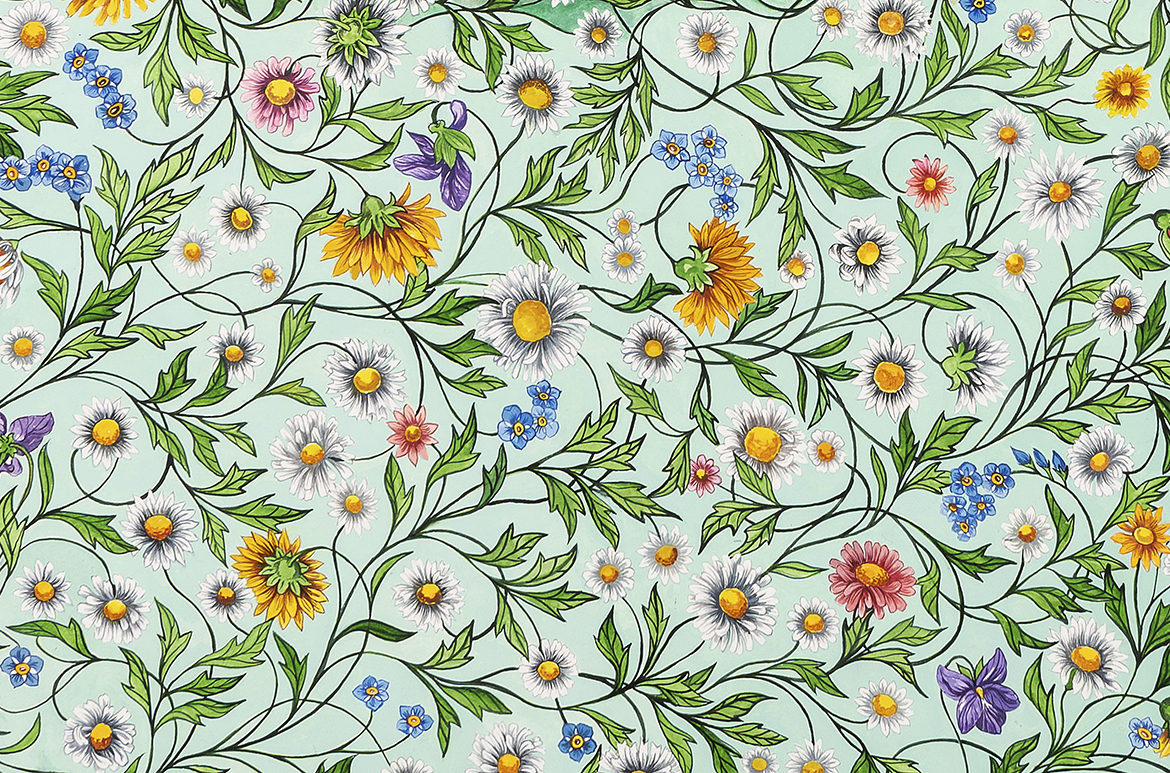
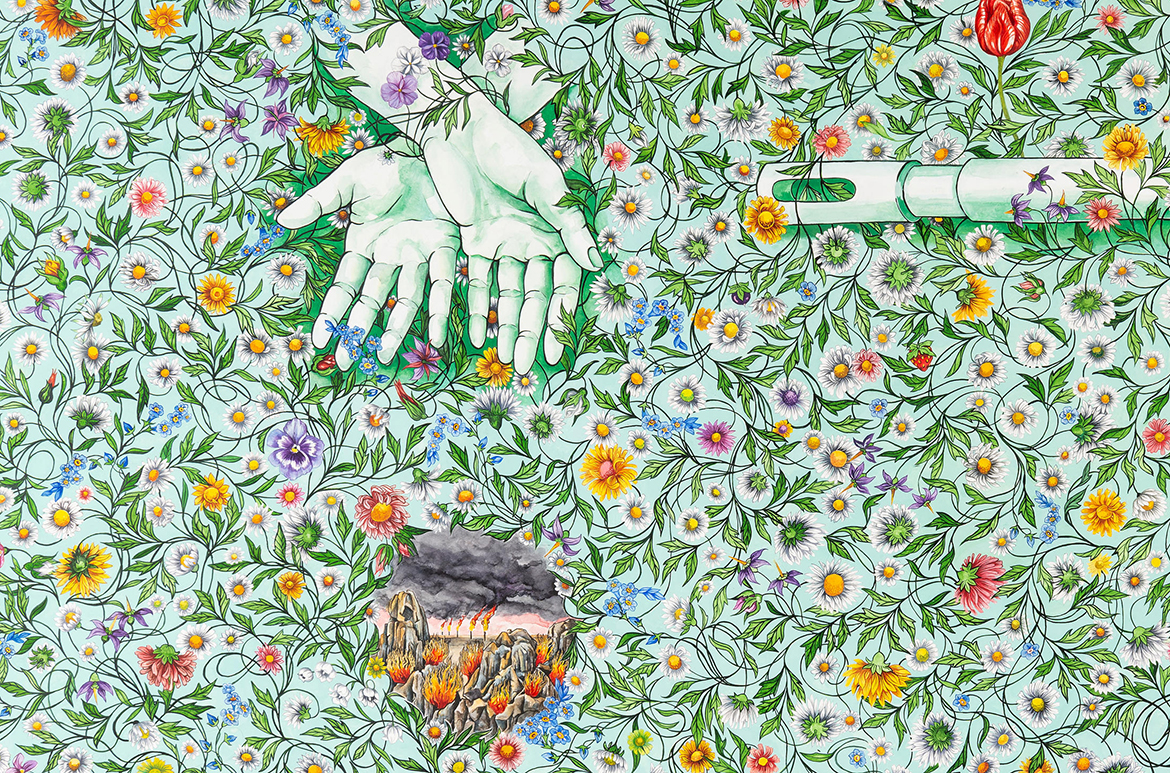
eX de Medici ‘I Won Her with My Heart’ 2018
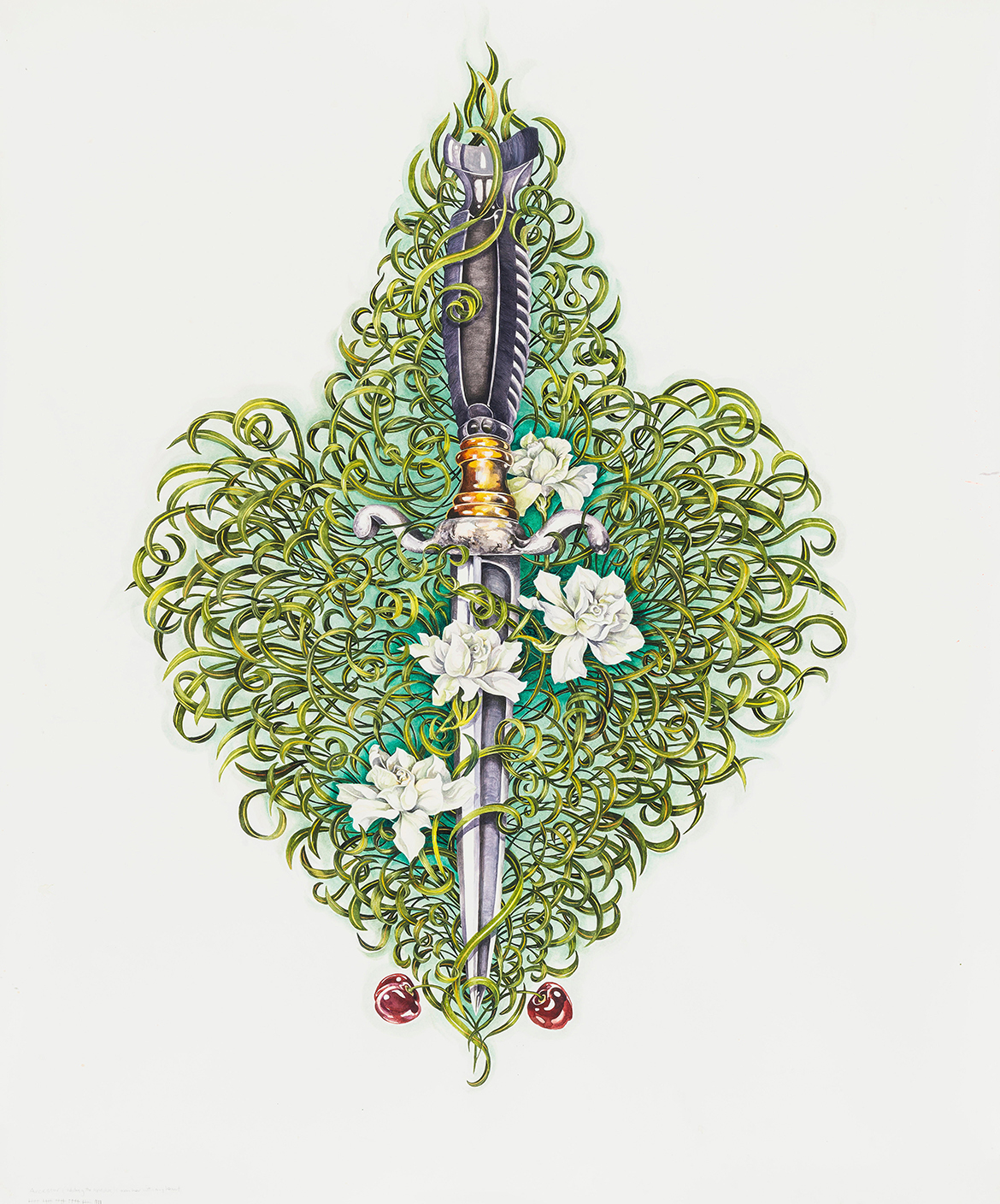
Samantha Littley is Curator, Australian Art, QAGOMA.
Endnotes
1 eX de Medici, ‘Plenary Session 1: Contemporary artists – eX de Medici’, filmed 20 January 2016, National Visual Arts
Education Conference (NVAEC), National Gallery of Australia, video: 12:28, <https://nga.gov.au/on-demand/nvaec-2016-
plenary-session-1-ex-de-medici/>, viewed 19 September 2022.
2 Rozsika Parker and Griselda Pollock, ‘Crafty women and the hierarchy of the arts’, Old Mistresses: Women, Art and Ideology,
IB Tauris & Co. Ltd, London and New York, 1981, p.58.
3 Linda Nochlin and Sutherland Harris quoted in Parker and Pollock, Old Mistresses: Women, Art and Ideology, p.55.
4 eX de Medici, email to the author, 9 March 2018.
5 See eX de Medici, ‘APT5: eX de Medici discusses her art practice and The Theory of Everything’, QAGOMA, https://www.
youtube.com/watch?v=3EjQ-R0V1lc, viewed 27 March 2023.
6 eX de Medici, ‘sp.’ [exhibition pamphlet], Helen Maxwell Gallery, Braddon, ACT, 2001, not paginated.
7 The American weapon that de Medici has reproduced is true to form with one exception — the buttstock and the barrel feature the latticed pattern that appears on the Russian prototype. See eX de Medici, email to the author, 1 March 2018.
8 eX de Medici, email to the author, 1 March 2018.
9 Shirin Ebadi and Hadi Ghaemi, ‘Broadcasting Tehran’s Repression’, Wall Street Journal, 9 December 2011, https://www.wsj.com/articles/B100014240529702049038045770799 70310000322?mod=go oglenews_wsj>, viewed 27 March 2023.
‘eX de Medici: Beautiful Wickedness’ in 1.2 and 1.3 (Eric and Marion Taylor Gallery) was at GOMA from 24 June until 2 October 2023. ‘Beautiful Wickedness’ offered opportunities for dialogue with ‘Michael Zavros: The Favourite‘ presented in the adjacent gallery 1.1 (The Fairfax Gallery) and 1.2.
#QAGOMA
